It looks like you're using an Ad Blocker.
Please white-list or disable AboveTopSecret.com in your ad-blocking tool.
Thank you.
Some features of ATS will be disabled while you continue to use an ad-blocker.
share:
(67-of-76) COVERT ACTION QUARTERLY & the Holocaust(s) … see 1-of-76 for legend & relevance to Holocaust denial

Number 68 (1999) East Timor; Colombia; Panama; Cuba vs. U.S.; Serbia; NATO in Kosovo; KLA and drugs; MPRI; Urban Warrior; Homeland defense; Poverty globalization.

Number 68 (1999) East Timor; Colombia; Panama; Cuba vs. U.S.; Serbia; NATO in Kosovo; KLA and drugs; MPRI; Urban Warrior; Homeland defense; Poverty globalization.
(68-of-76) COVERT ACTION QUARTERLY & the Holocaust(s) … see 1-of-76 for legend & relevance to Holocaust denial
Number 69 (2000) Congo; Chechnya; Colombia; Ecuador; Iraqi oil; Depleted uranium; Yugoslavia; India; Cyprus; Bosnia-Herzegovina; Seattle/WTO; “Emergency management;” Hunger politics; Global water; Climate; Prison-industrial complex; Military civil disturbance planning; CIA and Cold War.
Number 69 (2000) Congo; Chechnya; Colombia; Ecuador; Iraqi oil; Depleted uranium; Yugoslavia; India; Cyprus; Bosnia-Herzegovina; Seattle/WTO; “Emergency management;” Hunger politics; Global water; Climate; Prison-industrial complex; Military civil disturbance planning; CIA and Cold War.
Number 70 (2001) Bush and environment; Mullah Aid; Dick Held; Non-lethal weapons; Summit of the Americas; Israeli Nukes; Kissinger; Star Wars;
Yugoslavia; Antonin Scalia; Bush and Blair; Rep. Rob Simmons; 10 Worst Corporations; Statement by Leonard Peltier.
(69-of-76) COVERT ACTION QUARTERLY & the Holocaust(s) … see 1-of-76 for legend & relevance to Holocaust denial
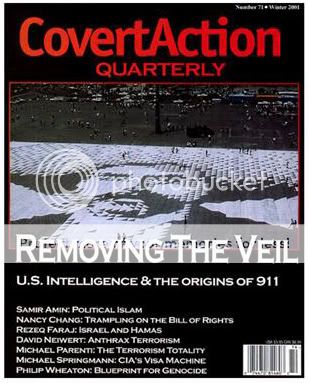
Number 71 (2001) Depleted uranium; Political Islam; Plan Puebla-Panama; USA Patriot Act; War Criminals; Israel and Hamas; Palestinian right of return; Domestic Anthrax; Plan Colombia; CIA visa machine; DoD vs. environment.

Number 71 (2001) Depleted uranium; Political Islam; Plan Puebla-Panama; USA Patriot Act; War Criminals; Israel and Hamas; Palestinian right of return; Domestic Anthrax; Plan Colombia; CIA visa machine; DoD vs. environment.
(70-of-76) COVERT ACTION QUARTERLY & the Holocaust(s) … see 1-of-76 for legend & relevance to Holocaust denial
Number 72 (2002) Police violence; ISI, CIA & Taliban; Palestine; Venezuela plotting & coup; Earl Silbert & Enron; US Designs on Iraq; Argentina bankrupted; Attack on Indian Parliament; Global rollback; Elie Hobeika.
Number 72 (2002) Police violence; ISI, CIA & Taliban; Palestine; Venezuela plotting & coup; Earl Silbert & Enron; US Designs on Iraq; Argentina bankrupted; Attack on Indian Parliament; Global rollback; Elie Hobeika.
(71-of-76) COVERT ACTION QUARTERLY & the Holocaust(s) … see 1-of-76 for legend & relevance to Holocaust denial
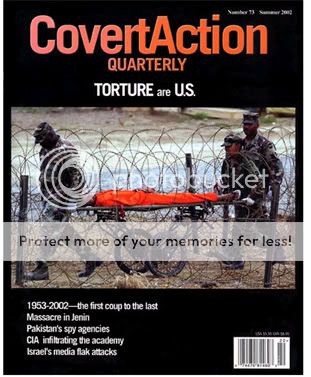
Number 73 (2002) Torture; Jenin and Amnesty International; Academia & CIA; Pakistan; 50 Years of Coups-Iran to Venezuela; Plutonium in Space; U’wa vs. Occidental; Why Nato?

Number 73 (2002) Torture; Jenin and Amnesty International; Academia & CIA; Pakistan; 50 Years of Coups-Iran to Venezuela; Plutonium in Space; U’wa vs. Occidental; Why Nato?
(72-of-76) COVERT ACTION QUARTERLY & the Holocaust(s) … see 1-of-76 for legend & relevance to Holocaust denial
Number 74 (2002) Jenin and Human Rights Watch; George Soros stage-managing imperialism; Religious fascists and the CIA in Bosnia; End of Posse Comitatus; Brown & Root; James Petras on Argentina; Rwanda injustice; Revving up Bush’s war machine; Smashing the Kurds.
Number 74 (2002) Jenin and Human Rights Watch; George Soros stage-managing imperialism; Religious fascists and the CIA in Bosnia; End of Posse Comitatus; Brown & Root; James Petras on Argentina; Rwanda injustice; Revving up Bush’s war machine; Smashing the Kurds.
(73-of-76) COVERT ACTION QUARTERLY & the Holocaust(s) … see 1-of-76 for legend & relevance to Holocaust denial

Number 75 (2003- 25th Anniversary Issue) U.S. – Made Hierarchy of Oppression from Baghdad to Bhopal; Homeland Security Poenix-Style; Space-Based Imperialism; First Nations Fight Back; Tobacco Smokescreen; Denver Police Files; Victory For Judi Bari; Presidential Deceits; When Will Bush Fall?

Number 75 (2003- 25th Anniversary Issue) U.S. – Made Hierarchy of Oppression from Baghdad to Bhopal; Homeland Security Poenix-Style; Space-Based Imperialism; First Nations Fight Back; Tobacco Smokescreen; Denver Police Files; Victory For Judi Bari; Presidential Deceits; When Will Bush Fall?
(74-of-76) COVERT ACTION QUARTERLY & the Holocaust(s) … see 1-of-76 for legend & relevance to Holocaust denial

Number 76 (2004) Edward Said Presente; Haiti's Murderous Army Reborn; "Gene Bombs"; Guantanamo Detainees; Racist War/Media on Iraq; IBM and Apartheid; Racism, Sexism, Militarism and John Kerry; World Social Forum, India.

Number 76 (2004) Edward Said Presente; Haiti's Murderous Army Reborn; "Gene Bombs"; Guantanamo Detainees; Racist War/Media on Iraq; IBM and Apartheid; Racism, Sexism, Militarism and John Kerry; World Social Forum, India.
(75-of-76) COVERT ACTION QUARTERLY & the Holocaust(s) … see 1-of-76 for legend & relevance to Holocaust denial

Number 77 (2004) Million Worker March, Israel-U.S. Against Iraq, Sabotage in North Korea, Cover-up of PanAm 103, Genocide in Chiapas, Hate Crime, A Kathy Kelly Diary.

Number 77 (2004) Million Worker March, Israel-U.S. Against Iraq, Sabotage in North Korea, Cover-up of PanAm 103, Genocide in Chiapas, Hate Crime, A Kathy Kelly Diary.
(76-of-76) COVERT ACTION QUARTERLY & the Holocaust(s) … see 1-of-76 for legend & relevance to Holocaust denial
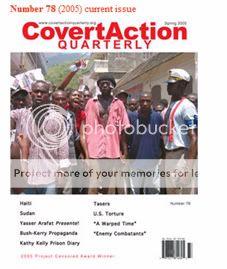
Number 78 (2005) current issue
Mod Note: You Have An Urgent U2U- Click Here.
[edit on 5-5-2008 by elevatedone]

Number 78 (2005) current issue
Mod Note: You Have An Urgent U2U- Click Here.
[edit on 5-5-2008 by elevatedone]
Fascist Coors beer co-founded (the camoflaged neo-nazi/fascist) Heritage Foundation.
I'm quoting myself from one of my books which I own the copyright to and give myself permission to do,
(-- which evolved into another neo-fascist organization called 'Free Congress Foundation, see end of post)
note: In post-WWII America, fascists and neo-nazis referred to anti-communisim terrorists and deathsquads as 'freedom fighters' ... the words 'free' and 'freedom' were a code word for neo-nazi and fascist 'anti-communist' activity such as murder, counter-revolution, destabilization and drug-running programs.
cont:
from wikipedia, www.sourcewatch.org...
for explanation fo the [0] footnotes see url for wikipedia, above.
Coors also funded the Contra's.
[edit on 9-5-2008 by counterterrorist]
I'm quoting myself from one of my books which I own the copyright to and give myself permission to do,
Paul Weyrich supported The Society for the Protection of Tradition, Family & Property, a neo-Fascist Catholic renegade sect. In 1973, Coors beer ruling family financed Paul Weyrich, to found, ‘The Heritage Foundation’.
In 1974, about the time members of Bill Casey’s money-issuing family investment banking group who sat on CIA Board of Directors passed along the names of Paul Nitze, Richard Pipes and Dan Graham to Bill Casey to give to CIA Director George Bush, letting Bush know to give full CIA cooperation to the new Committee on the Present Danger
-- this was the Bush CIA's plan following Gov. Reagan’s Operation Cable Splicer that preceded the Reagan/Bush Administration’s Operation Northwoods plan that all became The Project For The New American Century ...
... the Coors ruling family also financed Paul Weyrich to found, ‘The Committee for the Survival of a Free Congress’
(-- which evolved into another neo-fascist organization called 'Free Congress Foundation, see end of post)
note: In post-WWII America, fascists and neo-nazis referred to anti-communisim terrorists and deathsquads as 'freedom fighters' ... the words 'free' and 'freedom' were a code word for neo-nazi and fascist 'anti-communist' activity such as murder, counter-revolution, destabilization and drug-running programs.
cont:
Coors heavily funded both organizations, both far to the right of traditional Republican Conservatism ...and, far to the right of Right-Wing Republicans ...many people referred to the Heritage Foundation, and Free Congress Foundation, as neo-Fascist organizations ... determined to eliminate civil rights and liberties of non-ruling family everyday Americans.
Paul Weyrich was pretty good dancing between the Republican-right, the Republican far-right, the Christian right, the Christian far-right, and the fascist-right ... but, it wasn’t pretty. The better he danced, the more fascist dollars flowed in.
In 1976, Paul Weyrich, William Rusher, Morton Blackwell, and Richard Vigary tried to takeover the racist, ‘American Independent Party’, formed by racist Governor George Wallace, in 1968. Many American Independent Party members were members of Ku Klux Klan, John Birch Society ...and, Christian Front. Paul Weyrich was a defender of White culture ... like neo-Nazi White supremacists are.
In 1982, Paul Weyrich had an essay published. He explained, “Culturally destructive government policies of racial hiring quotas and racial busing are immediately important in the realm of action to the New Right, since the damage they do is enormous, irremediable.”
Weyrich’s defense of ‘white culture’ reflected theories advocated by neo-Nazi white supremacists.
from wikipedia, www.sourcewatch.org...
"Although it leads the 'Dirty Dozen' list, the Coors family and its firm have a long history of association with right wing Christian movements. Joe Coors was notorious for his battle against union representation for beer plant workers. In 1971, Coors joined with Bill Bright (founder of Campus Crusade for Christ) and strategist Paul Weyrich to form a political alliance. By 1974, the trio had established the Heritage Foundation and the Committee for the Survival of a Free Congress. Heritage Foundation went on to become one of the most influential think tanks in America, providing support and research for Ronald Reagan and, later, George Herbert Walker Bush. The Committee was established to select and fund candidates in Congressional races who represented right-wing evangelical sentiments, particularly on issues such as abortion and Gay rights."[5]
"In the early 1970s, Paul Weyrich had already linked with the Coors family which funded the start-up of the Heritage Foundation in the early 1970s. In 1974, with money from the Coors family (and the Coors family is not exactly a bastion of minority-friendly sentiment), Weyrich also started the Committee for the Survival of a Free Congress, which later became the Free Congress Foundation. Since the beginning, the Heritage Foundation and the Free Congress Foundation have been led and/or received oversight by Weyrich, and their boards of directors are interlinked, sharing members back and forth.
"The Committee for the Survival of a Free Congress, targeted local elections, looking for candidates to back. The FCF required that the candidates they supported submit to a three-day workshop, and if the candidates toed the Weyrich party line, their elections would then receive campaign support from the CSFC.
"Richard Viguerie, king of the direct-mail fundraising industry in America, and the top national fundraiser at that time, worked with the CSFC in their direct-mail money-raising efforts."[6]
"Even the Free Congress Foundation's precursor, the Committee for the Survival of a Free Congress, used an anti-gay and anti-lesbian platform as a vehicle to attract and unite followers, and they were the forerunners in the national campaign to demonize homosexuality as a threat to Americans. Gays and lesbians had been so thoroughly suppressed that mainstream heterosexual America really knew little about the gay/lesbian community. Weyrich recognized early on that this ignorance could be manipulated into fear and then hatred--and then political power.[7] ...
"The Free Congress Foundation's efforts have been many; sometimes simply supporting a gay-hate group, sometimes sponsoring gatherings where anti-gay politicking is discussed, and sometimes actively working to demonize and scapegoat gays/lesbians. For instance, in 1977 the Committee for the Survival of a Free Congress -- the precursor to the Free Congress Foundation -- recommended cutoff of federal Legal Services Corporation assistance in legal matters involving gay and lesbian rights."[8]
for explanation fo the [0] footnotes see url for wikipedia, above.
Coors also funded the Contra's.
[edit on 9-5-2008 by counterterrorist]
These are the nazis, neo-nazis and fascists killing you slowly and quickly and responsible for 99% of all the wars in our families' lifetimes and
high gas and food prices, killing you and your friends, and keeping medical care from the sick and food from the hungry.
These are charts I re-typed myself copying public U.S. Congressional studies, there are 72 charts ... can you find the rest of them and let me know? Any commentaries of ownership are via Eustace Mullins' research.
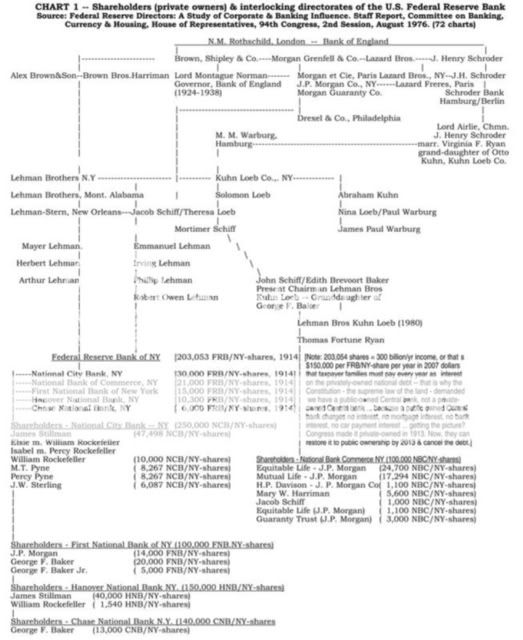
Add to the above chart via oldnslo: Moses Seif bank of Italy
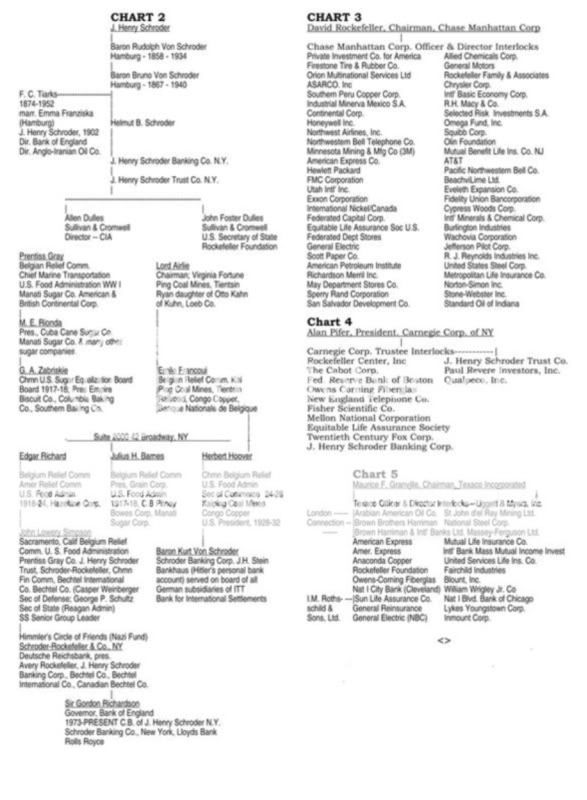
The information in the following chart on their ownership of fuel and energy and nuclear energy is from research by Antony Sutton. These folks own the Bank of England and Fed and all the major banks that own all the gas companies and utility companies and major food and medical companies .... gettin it? THESE ARE THE NEW WORLD ORDER ONE WORLD GOVERNMENT ENEMY out to enslave you economically, mentally and physically then kill you.
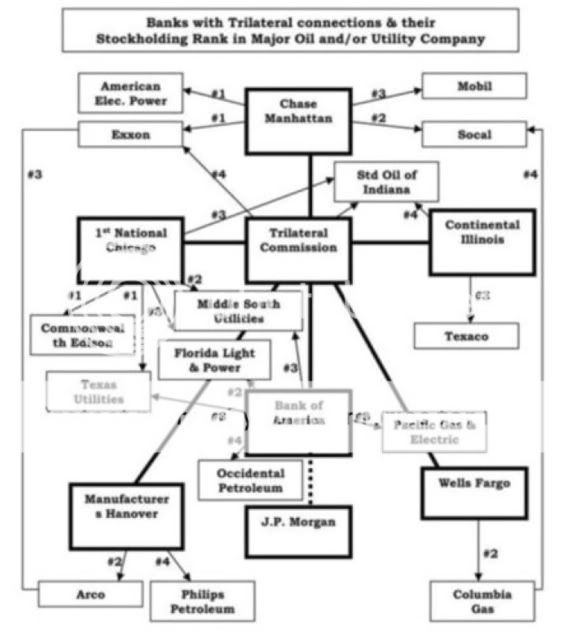
Here’s a birds-eye look at the know side of the nazi and neo-nazi fascist Bormann conspiracy folks – the private shareholders of the Fed and interlocking directorate with the Bank of England and City of London. These charts list the fascist people whose banks and other holdings and institutionalizations must be nationalized and returned to the people from whom this wealth was stolen in one form or another, either by low-paid labor, war, usurpation of mineral and water rights, theft and so on. None of these demonic institutions deserve to survive for they are greed and evil and usury incorporated into flesh.
The first two charts are from
In his Foreword to the study, Chairman Henry S. Reuss, (D-Wis) wrote:
[edit on 10-5-2008 by counterterrorist]
These are charts I re-typed myself copying public U.S. Congressional studies, there are 72 charts ... can you find the rest of them and let me know? Any commentaries of ownership are via Eustace Mullins' research.

Add to the above chart via oldnslo: Moses Seif bank of Italy

The information in the following chart on their ownership of fuel and energy and nuclear energy is from research by Antony Sutton. These folks own the Bank of England and Fed and all the major banks that own all the gas companies and utility companies and major food and medical companies .... gettin it? THESE ARE THE NEW WORLD ORDER ONE WORLD GOVERNMENT ENEMY out to enslave you economically, mentally and physically then kill you.

Here’s a birds-eye look at the know side of the nazi and neo-nazi fascist Bormann conspiracy folks – the private shareholders of the Fed and interlocking directorate with the Bank of England and City of London. These charts list the fascist people whose banks and other holdings and institutionalizations must be nationalized and returned to the people from whom this wealth was stolen in one form or another, either by low-paid labor, war, usurpation of mineral and water rights, theft and so on. None of these demonic institutions deserve to survive for they are greed and evil and usury incorporated into flesh.
The first two charts are from
Federal Reserve Directors: A Study of Corporate & Banking Influence, Staff Report, Committee on Banking, Currency & Housing, U.S. House of Representatives, 94th Congress,
2nd session, Aug. 1976, Federal Reserve Directors, a Study of Corporate & Banking Influence (72 charts)
In his Foreword to the study, Chairman Henry S. Reuss, (D-Wis) wrote:
"This Committee has observed for many years the influence of private interests over public responsibilities of the Federal Reserve System ... many companies in these tables have multiple interlocks to the Federal Reserve System. First Bank Systems, Southeast Banking Corp., Federated Department Stores, Westinghouse Electric Corporation, Proctor & Gamble, Alcoa, Honeywell, Inc., Kennecott Copper, Owens-Corning Fiberglass ... all have two or more director ties to district or branch banks. Federal Reserve directors are representatives of a small elite group that dominates the economic life of this nation.
[edit on 10-5-2008 by counterterrorist]
Aktion Adlerflug (1-of-22) -- The Bormann NWO Conspiracy leading to wtc/911.
Hermann Schmitz, former president of I.G. Farben, held as much stock in Standard Oil of New Jersey as did the Rockefellers. (Also, according to Loftus, the other two largest shareholders were two Saudi’s.)
Manning’s book, published in 1981, ‘Martin Bormann: Nazi in Exile’ documents that both Bormann and Mueller were alive in 1981 and were continuing to run the Bormann Organization. (This is documented in this post series, about 2/3’s through). The ‘old school’ Nazis wanted Manning to put them on TV to brag of the success of the Nazi flight capital continuing control of the NWO. “Neo-Nazis did not want Manning to put Bormann & Mueller on TV. The Bormann organization exists today, run by the new Nazis.
(The following two quotes are discussed in the last quarter of this Aktion Adlerflug series of posts.) How Bormann’s people operate in the contemporary commercial world. Post-war Jewish business cooperation with the Bormann Organization. If their proposals are sound, they are even provided with a venture capital fund.
According to Manning,
According to Manning,
Also note: As director of security for the Bormann organization, former Gestapo Chief Mueller worked directly with CIA (the CIA’s anti-Soviet bloc run by Gehlen, formerly Hitler’s chief of intelligence for Foreign Armies East to whom intelligence for Foreign Armies West reported).
Bormann’s FBI file.
---(from Manning’s book published in 1981, ‘Martin Bormann: Nazi in Exile’)
START: KEEP THE FOLLOWING IN MIND WHILE READING THIS POST (also see en.wikipedia.org... and note some of this source info is from Mike Ruppert's www.fromthewilderness.com... which references a story by Israeli Herzliyya International Policy Institute for Counterterrorism)
---Deutsche Bank/Alex Brown is the American investing banking arm of the German giant, Deutsche Bank, and was used to purchase some of the ‘put’ options on United Airlines stock immediately prior to and during WTC/911, and Alex Brown bank was previously chaired by former executive director of CIA, ‘Buzzy’ Krongard. A.B. Brown was acquired by Banker’s Trust in 1997 and became vice chairman when the two firms merged and became Banker’s Trust/AB Brown. Banker’s Trust/A.B. Brown. Banker’s Trust was acquired by Deutchebank in 1999, to form the single largest bank in Europe. Before 911, Kevin Ingram, an executor for Bankers Trust/Deutchebank pled guilty to laundering money to financing terrorist operations for groups linked to Osama bin Laden. Deutchebank has been a favorite of the bin Laden family and was connected to the hijackers and their support network. Deutchebank had corresponding relationships with banks in Bahrain and Kuwait that served George W. Bush when he engaged in illegal insider trading of shares of his company, Harken Energy. Mayo Shattuck III, head of the Brown/Deutchebank on 911, had previously been involved in Enron, helping them conceal their massive debt as well as involved in an insider trading scam involving Adnan Khashoggi’s ‘Genesis Intermedia’ immediately before 911. He was midway through a 3-year, 30 million dollar contract as head of Alex Brown when the attacks came, and under his management, some of the illegal trades on United Airlines were placed. Mayor Shattuck had taken over Alex Brown operations in 1997, after Krongard had officially gone to the CIA in 1998. Mayor Shattuck III resigned on the day after 911. A close associate of Council of Foreign Relations member Steven Bechtel of the Bechtel Corporation, Shattuck is now the CEO of Constellation Energy Group, one of the firms that participated in Vice President Dick Cheney’s Energy Task Force.
END.
[edit on 15-5-2008 by counterterrorist]
[edit on 15-5-2008 by counterterrorist]
Hermann Schmitz, former president of I.G. Farben, held as much stock in Standard Oil of New Jersey as did the Rockefellers. (Also, according to Loftus, the other two largest shareholders were two Saudi’s.)
Manning’s book, published in 1981, ‘Martin Bormann: Nazi in Exile’ documents that both Bormann and Mueller were alive in 1981 and were continuing to run the Bormann Organization. (This is documented in this post series, about 2/3’s through). The ‘old school’ Nazis wanted Manning to put them on TV to brag of the success of the Nazi flight capital continuing control of the NWO. “Neo-Nazis did not want Manning to put Bormann & Mueller on TV. The Bormann organization exists today, run by the new Nazis.
(The following two quotes are discussed in the last quarter of this Aktion Adlerflug series of posts.) How Bormann’s people operate in the contemporary commercial world. Post-war Jewish business cooperation with the Bormann Organization. If their proposals are sound, they are even provided with a venture capital fund.
According to Manning,
So much emphasis is placed on select Jewish participation in Bormann companies that when Adolf Eichmann was seized and taken to Tel Aviv to stand trial, it produced a shock wave in the Jewish and German communities of Buenos Aires. Jewish leaders informed the Israeli authorities in no uncertain terms that this must never happen again because a repetition would permanently rupture relations with the Germans of Latin America, as well as with the Bormann organization, and cut off the flow of Jewish money to Israel.
According to Manning,
“A revealing insight into this international financial and industrial network was given me by a member of the Bormann organization residing in West Germany. Meyer Lansky, he said, the financial advisor to the Las Vegas—Miami underworld sent a message to Bormann through my West German SS contact.
Also note: As director of security for the Bormann organization, former Gestapo Chief Mueller worked directly with CIA (the CIA’s anti-Soviet bloc run by Gehlen, formerly Hitler’s chief of intelligence for Foreign Armies East to whom intelligence for Foreign Armies West reported).
Bormann’s FBI file.
---(from Manning’s book published in 1981, ‘Martin Bormann: Nazi in Exile’)
"The file revealed that he had been banking under his own name from his office in Germany in Deutsche Bank of Buenos Aires since 1941; that he held one joint account with the Argentinean dictator Juan Peron, and ON AUGUST 4, 5, AND 14, 1967 HAD WRITTEN CHECKS on demand accounts in first National City Bank (Overseas Division) of New York, The Chase Manhattan Bank, and Manufacturers Hanover Trust Co., all CLEARED THROUGH DEUTSCHE BANK of Buenos Aires."
Bearer shares require no registration of identity, for such shares are exactly what they mean; the bearer of the majority shares controls the company without needing a vestige of proof as to how he acquired them. Thus the Germans who participated as a silent force in Bormann’s postwar commercial campaign—which is sometimes referred to by aging Nazis as ‘Operation Eagle’s Flight’ or ‘Aktion Adlerflug’-insured their command over the industrial and financial institutions that were to move the new Federal Republic of Germany back into the forefront of world economic leadership
START: KEEP THE FOLLOWING IN MIND WHILE READING THIS POST (also see en.wikipedia.org... and note some of this source info is from Mike Ruppert's www.fromthewilderness.com... which references a story by Israeli Herzliyya International Policy Institute for Counterterrorism)
---Deutsche Bank/Alex Brown is the American investing banking arm of the German giant, Deutsche Bank, and was used to purchase some of the ‘put’ options on United Airlines stock immediately prior to and during WTC/911, and Alex Brown bank was previously chaired by former executive director of CIA, ‘Buzzy’ Krongard. A.B. Brown was acquired by Banker’s Trust in 1997 and became vice chairman when the two firms merged and became Banker’s Trust/AB Brown. Banker’s Trust/A.B. Brown. Banker’s Trust was acquired by Deutchebank in 1999, to form the single largest bank in Europe. Before 911, Kevin Ingram, an executor for Bankers Trust/Deutchebank pled guilty to laundering money to financing terrorist operations for groups linked to Osama bin Laden. Deutchebank has been a favorite of the bin Laden family and was connected to the hijackers and their support network. Deutchebank had corresponding relationships with banks in Bahrain and Kuwait that served George W. Bush when he engaged in illegal insider trading of shares of his company, Harken Energy. Mayo Shattuck III, head of the Brown/Deutchebank on 911, had previously been involved in Enron, helping them conceal their massive debt as well as involved in an insider trading scam involving Adnan Khashoggi’s ‘Genesis Intermedia’ immediately before 911. He was midway through a 3-year, 30 million dollar contract as head of Alex Brown when the attacks came, and under his management, some of the illegal trades on United Airlines were placed. Mayor Shattuck had taken over Alex Brown operations in 1997, after Krongard had officially gone to the CIA in 1998. Mayor Shattuck III resigned on the day after 911. A close associate of Council of Foreign Relations member Steven Bechtel of the Bechtel Corporation, Shattuck is now the CEO of Constellation Energy Group, one of the firms that participated in Vice President Dick Cheney’s Energy Task Force.
END.
[edit on 15-5-2008 by counterterrorist]
[edit on 15-5-2008 by counterterrorist]
Aktion Adlerflug (2-of-22) -- The Bormann NWO Conspiracy leading to wtc/911.
(please note: much of this page was deleted because I mistakenly posted several paragraphs that were already on the preceding page -- sorry)
According to Manning:
[edit on 15-5-2008 by counterterrorist]
(please note: much of this page was deleted because I mistakenly posted several paragraphs that were already on the preceding page -- sorry)
According to Manning:
I observed that Mueller hadn’t lost his touch in the field of surveillance, judging by the quality, skill, and number of men and women who tracked me, at what must have been enormous cost, wherever I went in New York City, Washington, and overseas.
[edit on 15-5-2008 by counterterrorist]
Aktion Adlerflug (3-of-22) -- The Bormann NWO Conspiracy leading to wtc/911.
Bormann & Mueller in 1980.
START: ALSO KEEP THIS IN MIND, ---(from Manning’s book published in 1981, ‘Martin Bormann: Nazi in Exile’),
END
START: ALSO, KEEP THE NEXT THREE PARAGRAPHS IN MIND.
---(from Manning’s book published in 1981, ‘Martin Bormann: Nazi in Exile’)
Bormann & Mueller in 1980.
START: ALSO KEEP THIS IN MIND, ---(from Manning’s book published in 1981, ‘Martin Bormann: Nazi in Exile’),
With the war years far behind him, Martin Bormann goes on and on, quietly making history in worldwide financial circles. He was eighty on June 17, 1980, and his chief of security, Heinrich Mueller, was seventy-nine the same year. Bormann today may be likened to the classic chairman of the board of a vast international business complex, of an organization holding greater assets than any private investment house on Wall Street. Bormann, aged though he is, continues to guide the destiny of his financial empire. But he is sufficiently prudent and foresighted to realize that the assets he controls must be placed in younger hands, and today the leadership council of the senior NSDAP group is reflected in a younger generation, comprising professional managers, lawyers, and financiers, who are calling the shots as money and trade are moved among the markets of the Americas and Europe. Their organization holds the bearer bonds that give him a voice in banks and industries of Germany, and likewise they hold blue chip stocks in U.S. heavy industries and chemical companies. They are represented too on the boards of corporations in France, Belgium, Holland, Sweden, Luxembourg, and Switzerland, as well as in a myriad of other countries, including those in their bastion, Latin America. Their management is of the best and the companies they operate return a profit to everyone involved, from the West German government in corporate taxes and increased trade, to the shareholders of all companies that participated so long ago in Reichsleiter Bormann’s flight capital program.
END
START: ALSO, KEEP THE NEXT THREE PARAGRAPHS IN MIND.
---(from Manning’s book published in 1981, ‘Martin Bormann: Nazi in Exile’)
“When Bormann gave the order for his representatives to resume purchases of American corporate stocks, it was usually done through the neutral countries of Switzerland and Argentina. From foreign exchange funds on deposit in Swiss banks and in Deutsche Sudamerikanishe Bank, the Buenos Aires branch of Deutsche Bank, large demand deposits were placed in the principal money-center banks of New York City; National City (now Citibank), Chase (now Chase Manhattan N.A.), Manufacturers and Hanover (now manufacturers Hanover Trust), Morgan Guaranty, and Irving Trust. Such deposits are interest-free and the banks can invest this money as they wish, thus turning tidy profits for themselves. In return, they provide reasonable services such as the purchase of stocks and transfer or payment of money on demand by customers of Deutsche bank such as representatives of the Bormann business organizations and and Martin Bormann himself, who has demand accounts in three New York City banks. They continue to do so. The German investment in American corporations from these sources exceeded $5 billion and made the Bormann economic structure a web of power and influence. The two German-owned banks of Spain, Banco Aleman Transatlantico (now named Banco Comercial Transatlantico), and Banco Germanico de la America del Sur, S.A., a subsidiary of Deutsche Bank served to channel German money from Spain to South America, where further investments were made.”
Aktion Adlerflug (4-of-22) -- The Bormann NWO Conspiracy leading to wtc/911.
(CONT)
Argentina. NWO factories, hotels, resorts, cattle, banks, land, sugar and coffee plantations, metallurgy, insurance, electrical products, construction, and communications.
---(from Manning’s book published in 1981, ‘Martin Bormann: Nazi in Exile’)
Spain.
CONT.
END
Bormann founded 750 German firms outside of Germany to absorb Odessa Nazi flight capital.
Bormann replaces Hitler.
Bormann initiates ‘flight capital’ to preserve German (NWO) power after WWII.
Bormann sews up industrial & chemical patents in the U.S., Europe and Japan.
Concerns in the U.S., Europe and Japan willingly cooperate with Bormann.
Schmitz owned just as much stock in Standard Oil (Exxon) as the Rockefellers.
(CONT)
Argentina. NWO factories, hotels, resorts, cattle, banks, land, sugar and coffee plantations, metallurgy, insurance, electrical products, construction, and communications.
---(from Manning’s book published in 1981, ‘Martin Bormann: Nazi in Exile’)
“Argentina was the mecca for such money in the Western Hemisphere, and when Bormann gave the go-ahead in his overall flight capital program after the decisions at Strasbourg, over $6 billion of this money flowed into Buenos Aires for investment there and elsewhere in Latin America. The investments covered factories, hotels, resorts, cattle, banks, land, sugar and coffee plantations, metallurgy, insurance, electrical products, construction, and communications. It as much the same investment spectrum as established in Spain. West German investments today account for nearly 45 percent of all foreign investments in Spain.”
Spain.
CONT.
French financial institutions were central to the Bormann plan. “Before D-day four Paris banks, Worms et Cie., Banque de Paris et de Pays-Bas, Banque de l’Indochine (now with ‘et de Suez’ added to its name), and Banque Nationale pour le Commerce et l’Industrie (now Banque Nationale de Paris), were used by Bormann to siphon NSDAP and other German money in France to their bank branches in the colonies, where it was safeguarded and invested for its German ownership.”
END
Bormann founded 750 German firms outside of Germany to absorb Odessa Nazi flight capital.
Country by country, a breakdown by U.S. treasury investigators of these new 750 German firms was as follows: Portugal, 58; Spain, 112; Sweden, 233; Switzerland, 214; Turkey, 35; Argentina, 98."
Bormann replaces Hitler.
Bormann initiates ‘flight capital’ to preserve German (NWO) power after WWII.
Bormann sews up industrial & chemical patents in the U.S., Europe and Japan.
Concerns in the U.S., Europe and Japan willingly cooperate with Bormann.
Schmitz owned just as much stock in Standard Oil (Exxon) as the Rockefellers.
Aktion Adlerflug (5-of-22) -- The Bormann NWO Conspiracy leading to wtc/911.
Muller describes his work on his book ‘Martin Bormann: Nazi in Exile’),
According to Manning in his book published in 1981, ‘Martin Bormann: Nazi in Exile’, page 11,
In response to losing WWII, Hitler ordered the destruction of German industry. Bormann countermanded that order.
---(from Manning’s book published in 1981, ‘Martin Bormann: Nazi in Exile’)
Bormann outmaneuvered Goering, Goebbels, Himmler and Speer to succeed Hitler.
---(from Manning’s book published in 1981, ‘Martin Bormann: Nazi in Exile’)
Bormann now led Germany and the NWO.
---(from Manning’s book published in 1981, ‘Martin Bormann: Nazi in Exile’)
Muller describes his work on his book ‘Martin Bormann: Nazi in Exile’),
I encountered less resistance from Martin Bormann and his aging peers than I did from the cover-up groups in West Germany, Paris, London, Washington, and Wall Street.
According to Manning in his book published in 1981, ‘Martin Bormann: Nazi in Exile’, page 11,
I was the object of diligent observation by squads of Gestapo agents dispatched from South America by General “Gestapo” Mueller, who directs all security matters for Martin Bormann, Nazi in exile, and his organization, the most remarkable business group anywhere in the secret world of today.
In response to losing WWII, Hitler ordered the destruction of German industry. Bormann countermanded that order.
---(from Manning’s book published in 1981, ‘Martin Bormann: Nazi in Exile’)
Bormann waited nearly four weeks until the right moment came to go against Hitler’s directive. It came when Albert Speer, minister for armaments and war production, sent a teletype on September 5, 1944, to headquarters for Hitler’s attention. In this message, Speer outlined the realistic reasons why industrial plants should not be destroyed; Bormann lost no time sending this on to all the Gauleiters of Germany with his own imperative: “On behalf of the Fuehrer I herewith transmit to you a communication from Reichsminister Speer. Its provisos are to be observed strictly and unconditionally.”
Bormann outmaneuvered Goering, Goebbels, Himmler and Speer to succeed Hitler.
---(from Manning’s book published in 1981, ‘Martin Bormann: Nazi in Exile’)
Speer had commented, “Even Bormann had played along with me. He seemed to be more aware than Hitler of the fearful consequences of total devastation.” Speer also noted, in this month of September 1944, that “Hitler’s authority in the party was no longer what it had been.” Such authority had long since passed quietly to Reichsleiter Bormann, who had succeeded in outmaneuvering all the old gang: Goering, Goebbels, Himmler, the various generals, and Speer, who was told in 1944 by Hitler always to deal directly with Bormann on all matters. As Speer put it, “I had lost for good.” He was embittered and envious, and his feelings were to color every utterance he made about the Reichsleiter.
Bormann now led Germany and the NWO.
---(from Manning’s book published in 1981, ‘Martin Bormann: Nazi in Exile’)
Martin Bormann was now the leader in fact of Germany. Hitler, exhausted, drained of the charisma of the glory days of the thirties and the conquest years of the early forties, was going through the gestures of military leadership mechanically as his troops fell back on all fronts. Martin Bormann, forty-one at the fall of Berlin, and strong as a bull, was at all times at Hitler’s side, impassive and cool. His be-all and end-all was to guide Hitler, and now to make the decisions that would lead to the eventual rebirth of his country. Hitler, his intuitions at peak level despite his crumbling physical and mental health in the last year of the Third Reich, realized this and approved of it. “Bury your treasure,” he advised Bormann, “for you will need it to begin a Fourth Reich.” That is precisely what Bormann was about when he set in motion the “flight capital” scheme August 10, 1944, in Strasbourg. The treasure, the golden ring, he envisioned for the new Germany was the sophisticated distribution of national and corporate assets to safe havens throughout the neutral nations of the rest of the world.
Aktion Adlerflug (6-of-22) -- The Bormann NWO Conspiracy leading to wtc/911.
I.G. Farben controlled 380 companies in 93 countries, controlling over 2,000 global patents governing or example, Standard Oil (Exxon), DuPont, Dow Chemical, Kuhlman (in France) and Mitsui (in Japan).
---(from Manning’s book published in 1981, ‘Martin Bormann: Nazi in Exile’)
An example of I.G. Farben owning 51% of many companies.
---(from Manning’s book published in 1981, ‘Martin Bormann: Nazi in Exile’)
Bormann gave himself nine months to succeed.
---(from Manning’s book published in 1981, ‘Martin Bormann: Nazi in Exile’)
I.G. Farben controlled 380 companies in 93 countries, controlling over 2,000 global patents governing or example, Standard Oil (Exxon), DuPont, Dow Chemical, Kuhlman (in France) and Mitsui (in Japan).
---(from Manning’s book published in 1981, ‘Martin Bormann: Nazi in Exile’)
I.G. Farben had been the largest single earner of foreign exchange for Germany during the years of the Third Reich. Its operations in Germany included control of 380 companies with factories, power installations, and mines, as well as vast chemical establishments. It operated in 93 countries and the sun never set on I.G. Farben, which had a participation, both acknowledged and concealed, in over 500 firms outside Germany. They grew as the Third Reich did, and as German armies occupied each country in Europe they were followed by Farben technicians who built further factories and expanded the I.G. investment to RM (Reichsmarks) 7 billion. The Farben cartel agreements involving trade and the related use of its chemical patents also numbered over 2,000, including such major industrial concerns as Standard Oil of New Jersey (now Exxon), the Aluminum Company of America, E.I. du Pont de Nemours, Ethyl Export Corporation, Imperial Chemical Industries (Great Britain), Dow Chemical Company, Rohm & Haas, Etablissments Kuhlman (France), and the Mitsui interests of Japan.
An example of I.G. Farben owning 51% of many companies.
---(from Manning’s book published in 1981, ‘Martin Bormann: Nazi in Exile’)
The large French chemical interests of Kuhlmann also had their agreements with I.G. Farbenindustrie long before the war. Then, when France fell, this relationship ripened, expanding into full German majority control and stock ownership. The I.G. board of directors formed a new French holding company, capitalized at 800 million francs, and named it Francolor; it held the stock of Kuhlmann and other French dye and chemical interests. Fifty-one percent of Francolor’s stock was acquired by I.G. Farbenindustrie, without whose basic patents no chemical company in Europe could operate. The Germans were also diligent in acquiring stock control in other prime industries, and when their troops were forced from France in 1944, their economic imprint would remain.
Bormann gave himself nine months to succeed.
---(from Manning’s book published in 1981, ‘Martin Bormann: Nazi in Exile’)
When Reichsleiter Bormann accepted the fact that the war was lost, he gave himself nine months to place into operation his flight capital program of safe haven for the liquid assets of Germany. Little Alsace-Lorraine was a microcosm of Nazi takeovers in the rest of occupied Europe as regards commerce, industry, and banking. They had fitted the iron and steel industry of Lorraine into their vast International Steel Cartel and had “Aryanized” Jewish concerns, which meant outright appropriation.
Aktion Adlerflug (7-of-22) -- The Bormann NWO Conspiracy leading to wtc/911.
Deutsche Bank – a key element of the NWO.
---(from Manning’s book published in 1981, ‘Martin Bormann: Nazi in Exile’)
The Nazis continue to go underground to survive military defeat.
---(from Manning’s book published in 1981, ‘Martin Bormann: Nazi in Exile’)
Bormann’s underground flight capital program to preserve the NWO.
---(from Manning’s book published in 1981, ‘Martin Bormann: Nazi in Exile’)
Deutsche Bank – a key element of the NWO.
---(from Manning’s book published in 1981, ‘Martin Bormann: Nazi in Exile’)
I.G. Farben assumed control of the potassium mines of Alsace. The insurance business, which had been largely underwritten by French and British companies, was transferred to German companies. The big German banks, such as Deutsche Bank, Commerzbank, and Dresdnerbank, purchased majority shares of the Alsace-Lorraine banks, the institutions that under occupation controlled the very life and economy of the people.
The Nazis continue to go underground to survive military defeat.
---(from Manning’s book published in 1981, ‘Martin Bormann: Nazi in Exile’)
With the disastrous conflict-to-come looming after August 10, 1944, the realists—that is to say, Bormann, the Ruhr industrialists, and the German bankers—knew it was time for new and secretive directions, were Germany to survive and emerge from defeat to once more become a world leader.
Bormann’s underground flight capital program to preserve the NWO.
---(from Manning’s book published in 1981, ‘Martin Bormann: Nazi in Exile’)
When Reichsleiter Martin Bormann, through an emissary, informed a gathering of Nazi industrialists in Strasbourg on August 10, 1944, “The war cannot be won by us; we must take steps in preparation for a postwar commercial campaign,” he made just that possible by putting into action his new German state policy: the flight of capital—that is to say, money, patents, scientists, administrators—to neutral nations where this wealth would develop free of seizure by the Allies. This Bormann program of flight capital to safe havens, together with the endeavors of the German people, the grants of Marshall Plan money for reconstruction of factories, and the investment money that eventually found its way back home, moved the new West German Federal Republic forward to its present prosperity.
new topics
-
Tesla Cybertruck Explodes in Front of Trump Hotel in Las Vegas
Mainstream News: 3 hours ago -
Maybe they didn't get away with it: The Lincoln-Kennedy assassination parallels. 7 sentences long.
History: 6 hours ago -
Ukraine halts transit of Russian gas to Europe after a prewar deal expired
Political Conspiracies: 10 hours ago
top topics
-
Vehicle Strikes people in New Orleans
Mainstream News: 13 hours ago, 23 flags -
Tesla Cybertruck Explodes in Front of Trump Hotel in Las Vegas
Mainstream News: 3 hours ago, 14 flags -
Ukraine halts transit of Russian gas to Europe after a prewar deal expired
Political Conspiracies: 10 hours ago, 10 flags -
Welp...Happy New Year!!
General Chit Chat: 12 hours ago, 7 flags -
The Hand that Rocks the Cradle - Labour Plans “diversities of our society” Curriculum Change
Regional Politics: 13 hours ago, 6 flags -
Maybe they didn't get away with it: The Lincoln-Kennedy assassination parallels. 7 sentences long.
History: 6 hours ago, 4 flags
active topics
-
Vehicle Strikes people in New Orleans
Mainstream News • 218 • : BernnieJGato -
Tesla Cybertruck Explodes in Front of Trump Hotel in Las Vegas
Mainstream News • 27 • : TzarChasm -
Ukraine halts transit of Russian gas to Europe after a prewar deal expired
Political Conspiracies • 102 • : visitedbythem -
Can someone 'splain me like I'm 5. Blockchain?
Science & Technology • 98 • : TzarChasm -
Happy New Year from Aussie
General Chit Chat • 23 • : bally001 -
Get Ready - Here comes the Bird Flu Pandemic - Millions are Notified
Diseases and Pandemics • 64 • : cherokeetroy -
Strange fog all over the northern hemisphere
General Conspiracies • 40 • : annonentity -
Maybe they didn't get away with it: The Lincoln-Kennedy assassination parallels. 7 sentences long.
History • 8 • : Dalamax -
-@TH3WH17ERABB17- -Q- ---TIME TO SHOW THE WORLD--- -Part- --44--
Dissecting Disinformation • 3878 • : xuenchen -
I dont understand what i just witnessed
Social Issues and Civil Unrest • 27 • : Oldcarpy2
